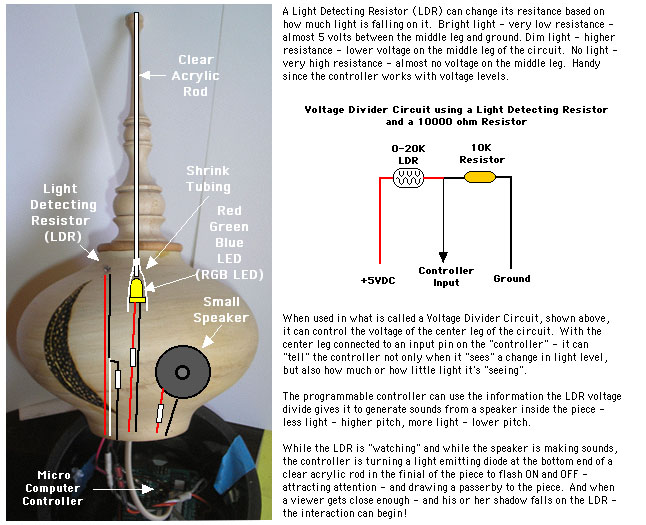Having played with a programmable Arduino micro controller enough to understand just some of the ways it can be used to do things with light and sound - it was time to incorporate some of those capabilities in a turning. The first piece I did was The Youngest Sister. I needed light and sound - and some way to trigger one or both.
The Youngest Sister is tall and slender - so a tall thin finial was obvious. Adding light to the top of the finial was also obvious. Drill a long small diameter hole through a blank and turn a finial to hide a piece of fiber optic cable inside. Stick and LED under it, hidden inside the hollow form and light is carried up the fiber optics and shines out the top of the finail. And to get "her" to react to changes in "her" environment I needed some sort of sensor that could "sense" that change.
A little searching through several tutorials on using a micro controller - specifically the Arduino I picked up at a Makers Faire - turned up something called an LDR - a LIght Detecting Resistor - and something called a Voltage Divider. Here's how an LDR Voltage Bridge is and how I used it for The Youngest Sister.

So as the light falling the LDR changes, the voltage on the Controller Input leg changes - which the controller reads - and converts to a number between 0 and 1023. So the controller can "see" - and distinguish - over a thousand levels of light. THAT is pretty sensitive.
Conveniently, the tutorial I found on using an LDR included using it to control a speaker, generating different pitches of sound based on what the LDR is "seeing". Little light getting to the LDR - high pitch and loud. Lots of light getting to the LDR - lower pitch and quieter -or no sound at all. By tweeking a few variables in the program you feed the controller, you can get the speaker to whistle - howl like a cat- - speak words - or sing.
So now I've got an ATTRACTOR to get a passerby's attention (the changing light on the tip of the finial), a SENSOR to detect changes in the surroundings (the LDR voltage bridge) and a REACTOR / RESPONDER to a change (sound coming from a small speaker - the sound changing based on the change),
I had the micro controller, a Radio Shack up the street for the parts I needed and I found sample programs (called Sketches to make them sound less intimidating) on the internet that use the components I was using to do things.
Now I had ANOTHER way to changes a static Just Sits There turning into a Dynamic Non Contact Interactive piece. Rather than relying on only light REFLECTED off the piece, now there's an Internal Lighti Light Source to play with. Rather than a passive Just Sits There piece, now there's dynamic interactivity - which doesn't require that you touch or hold the piece. And rather than a silent piece - there's sound. And now the piece changes - over time - rather than remaining static - fixed.